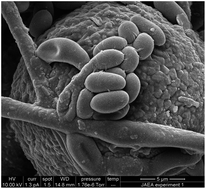Mineralogical comparisons of experimental results investigating the biological impacts on rock transport processes
Abstract
This study investigates the influence of microbes on fluid transport in sedimentary and igneous host rock environments. It particularly focuses on granodiorite rock (Äspö; Sweden) and mudstone (Horonobe; Japan) that were utilised during laboratory-based column experiments. The results showed that biofilms form on both rock types in low


 Please wait while we load your content...
Please wait while we load your content...